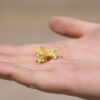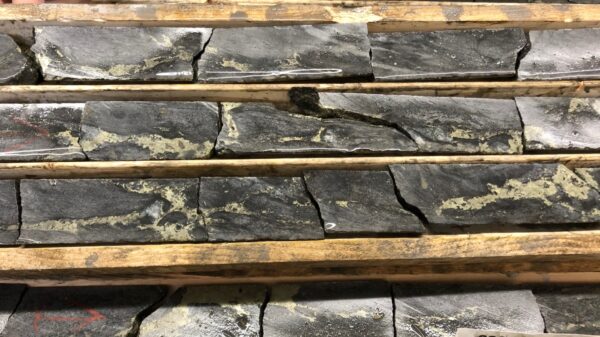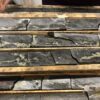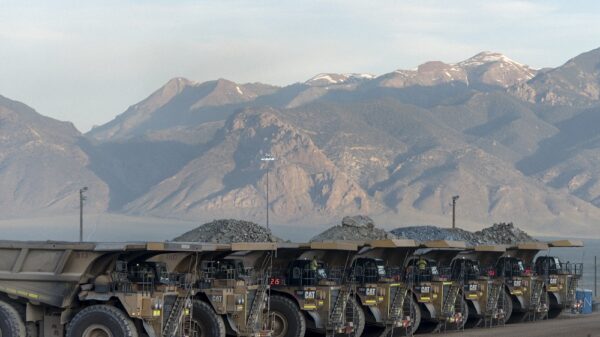Nevada King Gold Corp. (TSXV: NKG) (OTCQX: NKGFF) reported high grade gold assay results from its Atlanta Gold Mine Project in the Battle Mountain Trend in Nevada on Monday.
These holes include one core hole and three reverse circulation holes, and meet the western end of section 22-6N and tie into hole AT22HG-17, which returned 164.5 meters grading 0.93 g/t Au from 146.3 meters and bottomed in mineralization.
“With winter conditions now behind us, drilling progress within the West Atlanta Graben will accelerate. We will soon gain a much better understanding of the resource potential west of the West Atlanta Fault by testing a rectangular area measuring 300m wide and 500m long,” said Cal Herron, exploration manager of Nevada King.

Nevada King drill results. Image via Nevada King Gold.
Section 22-5N intersects with the newly defined West Atlanta Graben (WAG) target. This target is host to a thick section of mineralized volcanic and volcaniclastic sediments that have been down-dropped along the western flank of the West Atlanta Fault. Core hole AT22HG-8T has been drilled to extend the known mineralization to depth, and identified alongside nearby RC holes AT22SE-14 and 16 as the location of a post-mineral fault. The fault displaced the mineralization to the southwest of the Atlanta pit.

Location map for holes reported in this news release along section 22-05N(W) relative to the perimeter of the historical Atlanta Pit and 2020 Gustavson resource zone. Image via Nevada King Gold.
Mineralization along section 22-5N is 150 meters wide and ranges from 50 to 125 meters thick. Historical holes drilled by Gold Fields in 1990 on both sides of AT22HG-8T compare in grade and thickness to today’s hole. For example, returning 2.79 g/t Au over 94.5 meters in ARC-5 and 2.11 g/t Au over 113.4 meters in ARC-1.
Read more: NevGold assays high-grade silver at Ptarmigan, expands copper trend
Read more: Gold is still the best hedge against inflation: NevGold CEO
South Fault previously thought to be a through-going structure
The WAG’s southern end is a geologically complex area due to the intersection of east-west and north-south fault patterns. This complexity may be responsible for the higher grades and thicker mineralization seen along section lines 22-5N through 22-7N.
The South Fault was previously considered a through-going structure by both Kinross (TSX: K) (NYSE: KGC) and Mountain Valley Gold (CSE: MVMD) (OTCQB: MVMDF) (FRA: 20MP) (formerly Meadow Bay), terminating the southern end of the Atlanta resource zone. However, recent drilling by Nevada King in 2021 and 2022 has shown that the Atlanta Mine Fault Zone cuts through the South Fault. This discovery has extended mineralization further south into the south extension target.
“Nevada King will continue to focus on defining these high-grade zones that can have significant economic impact on a bulk-tonnage gold system. The Atlanta Au/Ag system is turning out to be much larger than previously envisioned, and with improving weather conditions we are eager to ramp up drilling to continue unlocking the property’s potential,” said Herron.
The company’s current interpretation of the fault pattern south of Section 5N/5N(W) has identified the potential for additional targets within the massive quartzite ridge that borders the southern rim of the pit. This ridge is currently categorized as strip material in the Gustavson resource model. However, if mineralized, it could provide the company with another game-changing opportunity by reducing strip ratios and allowing for a deeper pit in potential mining scenarios.
Nevada King Intercepts 2.74 g/t Au Over 89m Including 7.65 g/t Au Over 13.4m at New “West Atlanta Graben” Target at Atlantahttps://t.co/qNVQzfdkjB$NKG.V $NKGFF #NevadaKing #gold #exploration
— Nevada King Gold Corp. (@NevadaKingGold) April 3, 2023
Nevada King has identified a 140-meter zone between AT22HG-13 and AT22HG-8T, where severe core loss within the mineralized zone in ARC-1 and lack of depth penetration in AT22HG-9 exist. To explore this significant gap, the company is currently drill testing it.
Metallurgical testwork aimed at determining the amenability of volcanic-hosted mineralization for heap-leach recovery is being conducted utilizing PQ and HQ size core from AT22HG-8T. The results of these tests have shown that gold cyanide solubility assays within these volcanics are among the highest recorded to date on the property. This finding opens up the possibility of using a simple heap leach extraction method, which could positively impact the mining and processing costs.
Follow Joseph Morton on Twitter
joseph@mugglehead.com














